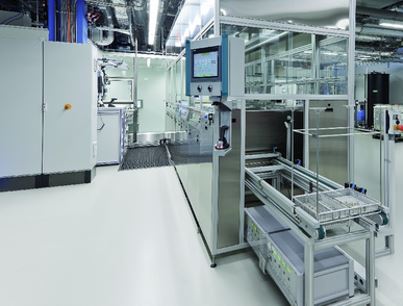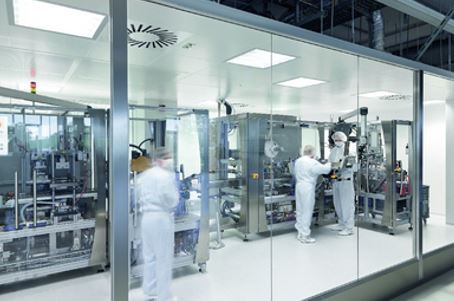Medical Technology
A comprehensive cleaning solution for „critical“ dental and medical products
Cleanliness adds value in medical equipment manufacturing
Products for use in dentistry and human medicine must meet the most exacting cleanliness standards – e.g., instruments classified as "critical" have to be sterile whenever they are used. In order to supply such items in an already sterilized state as an additional customer benefit, Gebr. Brasseler GmbH invested in a new cleaning and packaging facility that even includes a cleanroom. Around 12,000 different parts undergo in-process and final cleaning in an array of Ecoclean solvent-based cleaning systems and aqueous-type ultrasonic ultra-fine cleaning systems made by UCM AG.
The Komet trademark has its origin in 1923, when the Brasseler brothers founded the factory for dental drills bearing their name. Through innovation, precision and high quality, the company has evolved into a globally active manufacturer of medical instruments and equipment. Apart from instruments and systems for use in dentistry and dental technology, Brasseler GmbH & Co. KG's product portfolio also comprises rotary instruments for ENT and neurosurgery, arthroscopic shaver blades, and orthopedic surgery items such as saw blades, guide pins, cannulated screws and wires. Moreover, as a contract manufacturer, Komet makes customer-specific products for use in dental implantology as well as high-precision parts for diverse other branches of industry.
Reliable compliance with strictest cleanliness standards
Although its products are marketed in around 100 countries, the company conducts all development and manufacturing at its Lemgo site, relying on over 1,000 employees and around 1,000 production units. „In order to further improve our customer service, we invested in a new packaging concept and a cleanroom of around 250 sq.m. last year. This will enable us to produce up to 10 million instruments in sterile packaging for dental and medical uses each year. Our part cleaning operations had to be fully revamped as well in this context“, reports Helge Neitzel, Head of Abrasive Instrument Manufacturing at Gebr. Brasseler.
Accordingly, high demands were placed on the new in-process and pre-packaging cleaning equipment. Apart from cleanliness, the specification called for high throughput and availability rates as well as for a flawless technical documentation. Given the diversity of parts and materials – the company produces around 12,000 different items made of carbide metal alloys, stainless-grade and other steels, ceramics and titanium – it was necessary to provide several solvent-based cleaning systems to perform cleaning between the individual process steps. „This allows us to segregate the material flows and hence, to prevent cross-contaminations“, explains Marcus Becker, Cleaning Technology Group Leader at Gebr. Brasseler. Final product cleaning and the cleaning cycle ahead of product packaging in the cleanroom are performed with ultrasonic ultra-fine cleaning equipment using aqueous media. The company also thought it important to source both system types from the same manufacturer.
Cleaning trials and equipment technology tipped the scales
In quest of information relating to eligible equipment manufacturers, the project managers looked around at the parts2clean trade fair. Gebr. Brasseler then performed cleaning tests with six manufacturers. In the end the company opted for Ecoclean GmbH's solvent-based EcoCbase P2 and Compact 70P cleaning systems. Both models use modified alcohol which removes both polar and non-polar contaminants from the product. Cleaning and drying operations are performed under vacuum, so no additional explosion protection is necessary. When it came to the multi-chamber systems for ultra-fine cleaning, the customer chose the solution proposed by the Swiss UCM AG, a Ecoclean group company. „What mattered to us was the overall package – the advice received, the cleaning test results, equipment design and technology, the service network, and the price/performance ratio. Their offering matched our expectations exactly", Helge Neitzel justifies his company's decision.
Reproducible, fast and efficient solvent-based cleaning
Following diverse processing steps such as machining, grinding and coating, approx. 950,000 parts pass the solvent-based cleaning processes in two shifts every day. The control units can store eight cleaning programs each, selectable via a bar code depending on the cleaning step.
For reliable removal of the various contaminants – e.g., machining oil, grease or abrasive residue, chips, particles and chemicals from the galvanizing process – the systems possess two flooding tanks each for the pre-cleaning and main cleaning/degreasing operations. Additional steam degreasing features and ultrasound units ensure that the level of cleanliness required for the next downstream operation will be achieved reproducibly and efficiently. „And all this is performed in short treatment cycles. This is due, on the one hand, to the high vacuum power. On the other hand, the work chamber is filled very quickly thanks to the powerful pumps and large-diameter piping. Indeed, this is a point on which the Ecoclean systems distinguished themselves from competition", Marcus Becker adds.
Effective reconditioning of the solvent through continuous distillation plus full-flow and bypass filtration likewise contribute to the high cleaning quality. Some filters are equipped with magnetic inserts which improve the retention of metal chips.
Final cleaning with direct transfer into the cleanroom
Among ultrasound-based multichamber systems for ultra-fine cleaning, Brasseler was particularly impressed by the four-sided overflow feature developed by UCM, which is used on all tanks. In every tank, the cleaning or rinsing fluid is introduced from below, moves upwards, and then flows out over the rim on all sides. Foreign matter and particles are thus discharged from the tank without delay. This ensures an intense cleaning treatment of the product while also preventing re-contamination when the parts are lifted out of the bath.
„We found this feature on no other manufacturer's product. A further detail we liked about UCM's system are the so-called medicinal trays. Due to their special design, they prevent disease agents from accumulating and settling in the trays from where they might then contaminate the parts to be cleaned," Marcus Becker explains. The quality of the cleaning and rinsing baths is permanently monitored by sensors, even on ultra-fine cleaning processes.
In order to ensure that the segregation of materials achieved at the in-process cleaning level via the use of multiple cleaning lines will be maintained in final cleaning as well, the first cleaning stage comprises three tanks. These are followed by a rinse process, another cleaning step, and three rinsing steps of which the last two are carried out with de-mineralized water. To prevent any re-contamination of the parts in the hot-air drying process, the dryers are equipped with HEPA filters.
The 'pre-packaging cleaning' system is virtually identical. Here, the first cleaning step is carried out in a tray, irrespective of product material. In addition to the HEPA filters, laminar flow boxes are fitted above the last rinsing stage and the dryers. Moreover, the cleaning system and its conveyor unit are fully enclosed to ensure the cleanliness of all products entering the cleanroom.
For their intermediate and final cleaning processes, Gebr. Brasseler work with 16 cleaning programs in each case. Programs are selected via a bar code on the product routing documents, which is read by a scanner. „We can combine up to twelve orders in one batch. The control software checks automatically if all parts are to be cleaned by the same program. If this is not the case, an alarm signal is issued and the process cannot be started", Marcus Becker explains.
Equipment qualification, process development and validation
Except for one solvent-based system, all new cleaning equipment was qualified in compliance with EU and FDA (U.S. Food and Drug Administration) rules and the cleaning processes were validated accordingly. „Ecoclean and UCM cooperated with us in carrying out the necessary DQ, IQ and OQ qualification steps and in preparing the requisite documentation. They also helped us develop the diverse cleaning processes. Actually, the new equipment provides us with cleaning capabilities which exceed our current needs. We consider this an investment in the future, just like the new packaging solution and the cleanroom. It all helps us to further expand our market position," Helge Neitzel concludes.
Author: Doris Schulz


